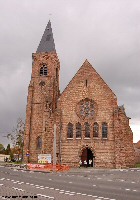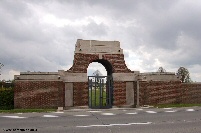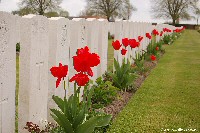Poelcapelle
The World War One Battlefields site is undergoing a major update, with pages being converted to a new, user-friendly mobile format. The updated pages can be found at Updated World War One Battlefields. Some pages such as this one remain in the original format pending update.
This page covers the village of Poelcapelle (today spelt Poelkapelle) and also Varlet Farm, located not far away from it. It also covers some sites at nearby Graventafel.
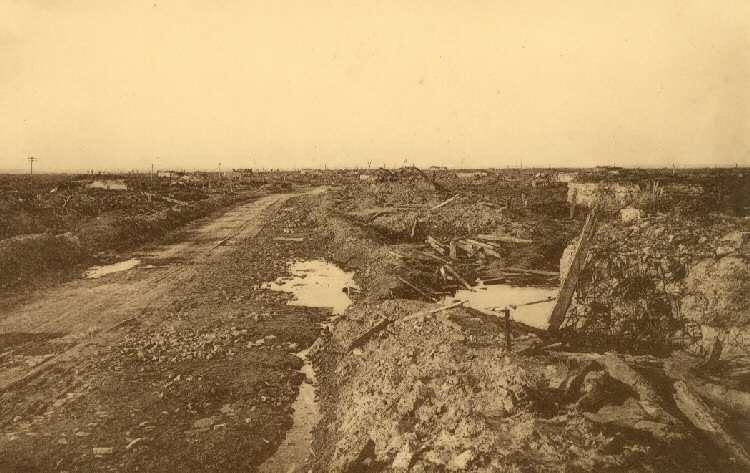
Poelcapelle just after the War. Photo: NELS
Poelcapelle Village
Poelcapelle is located about five miles north-east of Ypres, reached by following the N313. During the war it was a strongly fortified German position, which the British struggled to take during the Third Battle of Ypres. Although the line ran through the outskirts of the village for some time, it was not until the 22nd of October 1917 that the village was finally taken by the 10th Essex and 8th Norfolks, part of 53rd Brigade. The operation to take the village included the use of what was known as a "Chinese attack", where dummy figures were raised above the trenches to fool the Germans as to where the attack would actually take place.
In the centre of the village are two interesting sites; firstly the church. This, like the rest of the village, was destroyed during the war (see picture below), and after the war it was rebuilt in a completely different style.
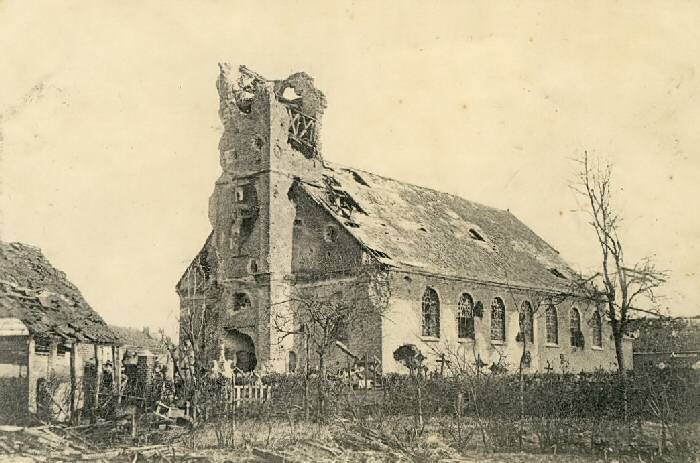
Poelcapelle church in about 1915
In the centre of the village, not far from the church and in the middle of a roundabout is a memorial to the French pilot Georges Guynemer. Guynemer was just 21 when he started flying in 1915, and as his tally of kills began to mount up he became a popular favourtie with the French people. He became leader of a squadron known as 'the storks', but the pressure on him told and he fell somewhere near Poelcapelle on the 11th of September 1917. His body was never found.
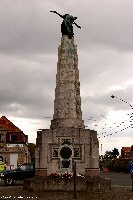
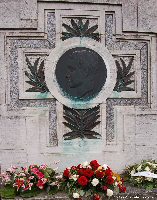
Guynemer memorial at Poelcapelle
Guynemer had totalled 53 confirmed kills before he died, and his loss was keenly felt by France. He had previously been awarded the Legion d'Honeuer medal, and this memorial surmounted by a stork was put up at Poelcapelle in the 1920s to commemorate him. The stork motif is also shown on the side of the column, as is a relief carving of Guynemer in profile.
Poelcapelle British Cemetery is reached by continuing past the church on the right, and then on the right hand side road. There are heavy double iron gates at the entrance, and mature trees line the front and right of the cemetery. There are small alcoves with benches set on the right hand wall. Below is a postcard view of the cemetery, taken perhaps between the wars, but todays view (beneath) is very similar.
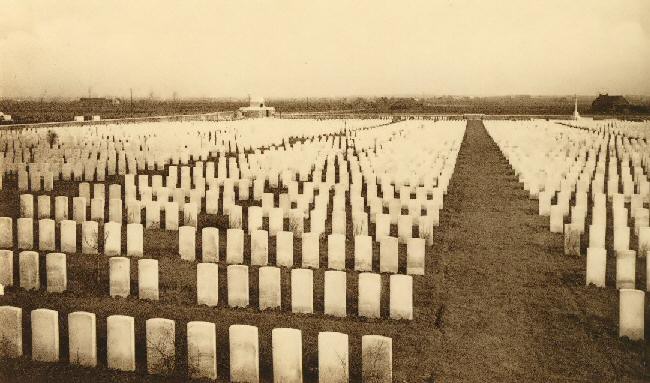
Poelcapelle British Cemetery perhaps between the Wars. Photo: NELS
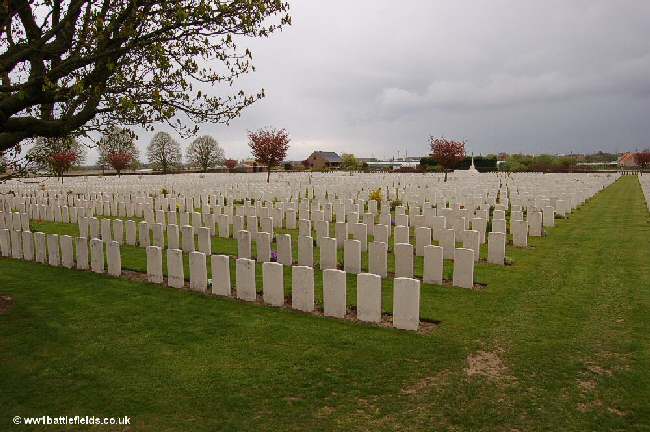
Poelcapelle British Cemetery today
This is a large cemetery, with nearly 7,500 burials and an astonishing 6,321 of these are unidentified. This reflects the nature of the cemetery; it was made after the Armistice by the recovery of graves from the battlefields around and also the concentration of graves from other cemeteries. Many of the burials are from the last half of the year 1917.
One grave here is said to be that of Private John Condon, listed in the cemetery details as aged 14 and 'thought to be the youngest battle casualty of the First World War commemorated by the Commission'. This is located in Plot LVI Row F grave 8, towards the back left of the cemetery. However, there is some dispute over the true age of Condon, and even whether it is he who is actually buried in this grave.
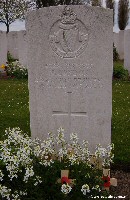
Grave of Private John Condon - but is the age and the identification correct?
On the left hand wall are special memorials - some to men believed to be buried here, and some to men buried by the Germans whose graves could not be located. There is a single Second World War grave in Plot 57, Row AA all by itself. The Stone of Remembrance is set slightly down in a rectangular area with semi-circular corners in front of the Cross of Sacrifice. This is one of the largest cemeteries in the Salient, but peaceful. Many of the unknown burials do have rank or unit identified on their headstones. I also noticed that in Plot 1 Row C a headstone to an unknown soldier did not have the words 'Known Unto God' inscribed on it.
Varlet Farm
Varlet Farm is located south-east of Poelcapelle, about midway between it and Passchendaele. It is well-signposted with yellow Information signs. It was marked on trench-maps during the war, and was taken by the Anson Battalion of the Royal Naval Division at 7.20 a.m. on the 26th of October 1917. A plaque was recently unveiled at the farm to commemorate this.
During the war a moat surrounded three sides of the farm buildings, which were probably fortified as they formed a part of the German front line here in 1917. Today Varlet Farm has been rebuilt, and the present buildings are 50-100 metres away from where the originals stood. Varlet Farm is owned by Charlotte Cardoen-Descamps and her family, and now as well as a farm operates as a bed and breakfast. Charlotte herself has become an expert on the Great War particularly in the local area. She has trench maps and aerial photographs showing Varlet Farm during the War, and eloquently describes an attack by the Hood Battalion of the Royal Naval Division to take the farm. This attack was unsuccessful, due largely to the appalling conditions at the time. Varlet Farm also has a large collection of Great War books which are available for visitors to consult during their stay, and there cannot be a better base for a battlefield visit to the Salient.
As a working farm the iron harvest here is part of the normal round, and over the years an incredible amount of material has come out of the ground. Some of this has been collected into a barn, and can be viewed by guests at Varlet Farm with commentary by Charlotte. Some pictures of this collection are shown below.
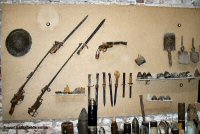
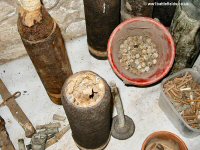
Various weapons (left) and a shrapnel shell and balls (right) at Varlet Farm
Other items which have been unearthed around the farm over the years can also be seen, including a German Maxim machine gun, as well as many shells in varying states of preservation.
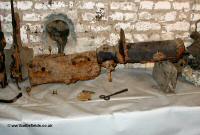
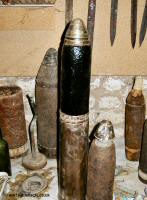
Maxim machine-gun (left) and various shells at Varlet Farm
There are also duckboards, as would have been found at the base of trenches to help in passing through these especially when the weather was poor. Another feature of trench warfare was 'silent pickets' - iron poles used to hold up barbed wire, which had a 'corkscrew' shape at their base so they could be screwed silently into the ground rather than having to be hammered in (thus drawing the attention of the enemy to the activity). There are various different heights, and it is also possible to distinguish between British and German varieties. Some of these artefacts are from other sites, including the Yorkshire trench near Boesinghe.
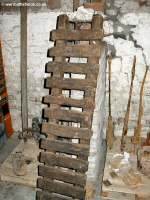
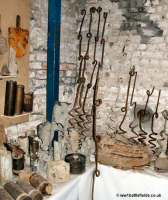
Duckboards, 'Silent pickets' and other artefacts at Varlet Farm
Varlet farm has a website at which more information on the accomodation and other information can be found.
PLEASE NOTE! Varlet Farm is a private residence and bed and breakfast establishment. It is not a museum with regular opening hours. The best way to see this collection is to base a visit at Varlet Farm.
s-Grafentafel
A little further to the south of Varlet Farm is the tiny hamlet of s-Graventafel (the name is spelt several different ways in various accounts). There are two sites of interest here, the first being a memorial to New Zealand soldiers. This is located at the cross-roads, and has an inscription in English on the front, and in French and Flemish on either side. Beneath the insignia is the legend 'This monument marks the site of Gravenstafel which on October the 4th 1917 was captured by the New Zealand Division as part of a general advance towards Passchendaele'.
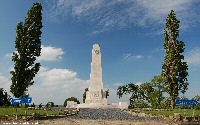
New Zealand Memorial at s-gravenstafel
In larger letters higher up the column are the words 'In honour of the men of the New Zealand Division. The Battle of Broodseinde 4th of October 1917'. At the base are the same words found on the other New Zealand memorials on the Western Front, emphasising how far the men of New Zeland came to fight in this war: 'From the Uttermost Ends of the Earth'.
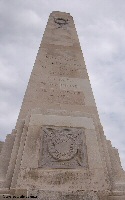
Closer view of the New Zealand Memorial at s-graventafel
A little away from the cross-roads heading south-west (in the direction of Wieltje and Ypres) is a small bunker set into the bank near a house.
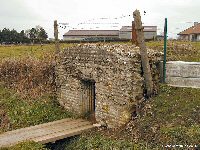
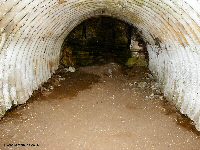
Bunker (left) and the interior of the bunker at s-graventafel
Sources & Acknowledgements
Beatrix Brice: Battle Book of Ypres
Charlotte Cardoen-Descamps at Varlet Farm
Commonwealth War Graves Commission website
Great War Forum
Major & Mrs Holt: Battlefield Guide to the Ypres Salient
The Times archives

